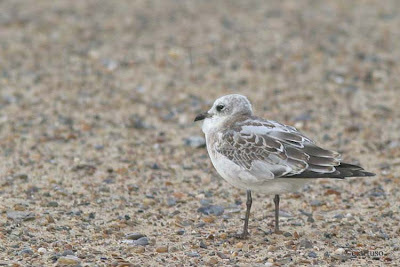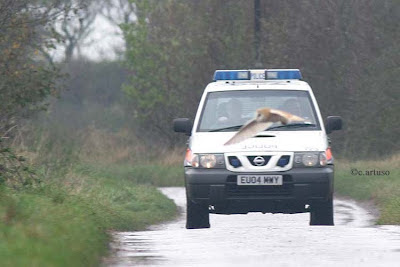This post features some of the common songbirds (passerines) of the British Isles and of course features species I photographed there in rough taxonomic order. Arguably the two most common swallow species (well, at least at the times of year i have visited) are the Common House Martin (left) and the Barn Swallow (right). North American birders will notice how much whiter below (as opposed to red) the Barn Swallow’s on this side of the pond are…
The pipits and wagtails (family Motacillidae) are much more diverse in the Palearctic than the Nearctic and there are at least 12 species in Europe as compared to 6 in North America. Some of the common species in the British Isles includes the aptly named Meadow Pipit,
the coast-dwelling Rock Pipit,
and the very common White Wagtail. The birds in Britain and Ireland (subspecies yarrellii) have a distinct plumage and some consider them to be a full species "Pied Wagtail".
The wrens (Troglodytidae) on the other hand are very much an "American" family, distributed throughout the Nearctic and Neotropics (North and South America) with only one species found in the Palearctic, the Eurasian Wren (split from the Winter Wren and Pacific Wren with which they were formally considered conspecific). The Eurasian Wren is a garden bird in Britain and elsewhere, so different from North America, where the larger House Wren occurs in that setting and our Winter Wren is a boreal forest species (at least where I live).
The White-throated Dipper is one of two dipper species in the Palearctic and the only one in western Europe.
The Dunnock is a member of the Accentor family (Prunellidae) and is also known as Hedge Accentor. Accentors are a small family (worldwide 13 species) that are basically confined to the Palearctic Realm (spill over slightly into the Oriental Realm in the Himalayas for example) that have short pointed bills and forage by hopping along the ground, especially at high elevations or northern areas.
The Palearctic has many species with the large family Muscicapidae, which of course translates (from Latin) as “flycatchers” (musca = fly, capere = to seize), generally referred to as “Old World flycatchers”. The common names of many of the birds in this “familiar” family (to Europeans), were later re-applied to unrelated species from different parts of the world. Hence today, North American flycatchers (tyrant flycatchers) and Old World flycatchers are unrelated, the American Robin is not closely related to the birds called robins in Europe (the American Robin is actually a thrush and not a robin), the American Redstart is a New World wood-warbler (different from Old World warblers of course) and not closely related at all to the 15 species of redstarts within the Muscicapidae family, and the bird North Americans call “chat” (Yellow-breasted Chat) is not closely related to the chats, which, like Old World robins, are usually placed with the Old World Flycatcher family. Here are a few examples. The European Stonechat (Stone Chat) is one of about 14 species in the genus Saxicola (different authors terat species limits differently in this genus). This is a female.
This is the dapper little European Robin (a.k.a Robin Redbreast). Like other species called robins in the Muscicapidae family in genera including Erithacus, Luscinia, Tarsiger and others, this is a very small bird (14 cm) that hops on the ground and often cocks or at least half cocks their tail. Most “robins” are very shy and some are ultra skulkers but the European Robin is a very familiar garden bird and easy to observe.
The wheatears (23 species in the genus Oenanthe with a mostly Palearctic and African distribution) are closely related to the “true” chats and robins. The only one to occur regularly in the U.K is generally called Northern Wheatear to distinguish them from the 22 others but most British birders simply refer to them as “wheatear”, a name that is said to be a euphemistic or “corrupted” pronunciation of the older name “white arse” referring to their prominent white rump. This bird is in fall / autumn plumage.
Here is yet another example of a borrowed name. This is the bird the British call “blackbird”, i.e. Eurasian Blackbird, featured in music and poetry, e.g. the beetles line “blackbird singing in the dead of night…”(yes, they do sing at night a lot). The Eurasian Blackbird is a thrush in the genus Turdus, i.e. congeneric with American Robin! Famed for the beautiful song and not closely related to the birds North Americans call “blackbirds” at all. This is a male, females are browner.
The Thrush family is well represented in the Palearctic. In addition to the Eurasian Blackbird above, here are some of the common U.K species. This is a Song Thrush, also in the genus Turdus.
Similar to Song Thrush but much larger and paler, this is a Mistle Thrush.
In fall and winter the thrushes that breed in the U.K are joined by some northern visitors such as this Redwing (also a Turdus thrush).
And yet another Turdus thrush, the Fieldfare.
The family Paridae (tits and chickadees) is well represented in the U.K. One of the most common garden birds is the European Blue Tit.
And there are various other similar species such as the Coal Tit,
and the Great Tit.
and, in a different family, Aegithalidae (Bushtits or long-tailed tits), there is the Long-tailed Tit, a.k.a Long-tailed Bushtit.
As mentioned above, “warblers” in the Old World and in the New World are very different. The taxonomy of the MANY species that are called warblers is somewhat complicated and in a bit of a state of flux it seems but the majority are now placed in a family called Sylviidae by the IOC. . Some of the genera of Old World warblers are very large, the genus Phylloscopus, which contains arguably some of the world’s most difficult species to identify by sight alone, contains no less than 62 species (and most of them look extremely similar). This is a Willow Warbler, one of the commonest in the U.K.
The Eurasian Treecreeper is one of two treecreeper species in Europe and the only one in the U.K. This widespread species is found across the Palearctic.
The Eurasian Jay is the European equivalent of North America’s Blue Jay although not a garden bird to the same extent.
The many finch species in the U.K offer a lot of colour and many of them regularly visit feeders. Most of the photos below were taken from the photo hide of the RSPB Lochwinnoch reserve near Glasgow. The Chaffinch is one of the commonest garden and feeder visitors. These three photos show a male, female then juvenile.
These next three photos show a male, female then juvenile Eurasian Siskin. This is also a common species.
These two photos show an adult then juvenile of the beautiful European Goldfinch.
And here are a male and female European Greenfinch, a most striking and large and "well-built" finch!
Of course this is only a small sampling of the birds of Great Britain.


































































